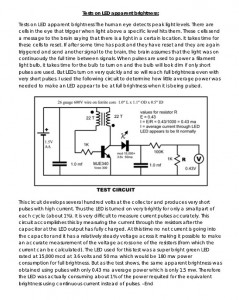 I downloaded Stiffler’s SEC (Spatial Energy Coherence) .PDF and I found this schematic on P.47. It’s supposed to be for testing how bright LEDs are with a very short pulse. I found the circuit to be designed for danger; the same high voltage that appears across the primary (collector connected) winding also appears across the feedback winding. And this is connected through the 1k resistor directly to the base of the transistor. When there is a positive 43 volts on the primary winding, there is a corresponding negative 43 volts on the feedback winding – the winding ratios are 1 : 1. The feedback winding is connected to the base without any form of protection against excessive voltage. We know from the datasheets of many transistors that the emitter to base junction is typically rated at a maximum of 5 or 6 volts reverse breakdown voltage, and if this is exceeded, the junction will break down and permanent damage to the transistor will occur. So why does he do this to his transistor? I don’t know. But it should not be done.
I downloaded Stiffler’s SEC (Spatial Energy Coherence) .PDF and I found this schematic on P.47. It’s supposed to be for testing how bright LEDs are with a very short pulse. I found the circuit to be designed for danger; the same high voltage that appears across the primary (collector connected) winding also appears across the feedback winding. And this is connected through the 1k resistor directly to the base of the transistor. When there is a positive 43 volts on the primary winding, there is a corresponding negative 43 volts on the feedback winding – the winding ratios are 1 : 1. The feedback winding is connected to the base without any form of protection against excessive voltage. We know from the datasheets of many transistors that the emitter to base junction is typically rated at a maximum of 5 or 6 volts reverse breakdown voltage, and if this is exceeded, the junction will break down and permanent damage to the transistor will occur. So why does he do this to his transistor? I don’t know. But it should not be done.
Instead, he should put a white or blue LED from base to emitter, with the cathode or flat spot towards the base. When the base goes negative greater than 3.3V, the LED conducts and the voltage never rises to greater than 3 or 4 volts negative.
Human eye I don’t agree with Stiffler’s assertion that “The human eye detects peak light levels.” The different wavelengths do different things when they enter the eye. I should say that different wavelengths affect different chemicals, but that may be too simple. In any case, I’m no expert on it and I think it should be left to an expert to say how the human eye responds to light.
He then uses the term “full brightness.” Well, what is full brightness? He doesn’t define it as being any measured value. And we all know how the human eye tricks us by opening the eye’s iris when the ambient light is dim and closing the iris when the ambient light is bright. This means that the eye is not capable of making a judgment of how bright full brightness is.
Instead he should go with a definition that is repeatable and measurable. Such as: The LED is at full brightness when there is 20 milliamps DC flowing through it (for a standard 5mm LED), or if the current is pulsed, then the current that is needed to equal the same brightness as 20 milliamps DC. For other size LEDs, instead of 20 milliamps, the current it should be set to is its maximum current.
I disabled comments due to comment spam. Please send email to my yahoo email address acmefixer.